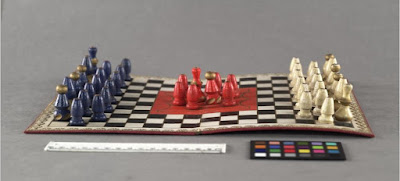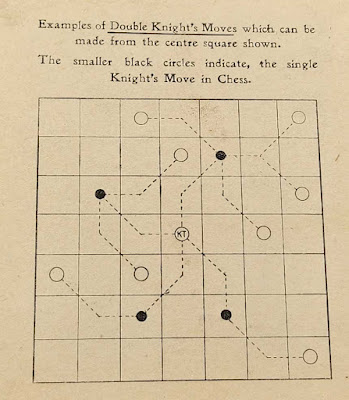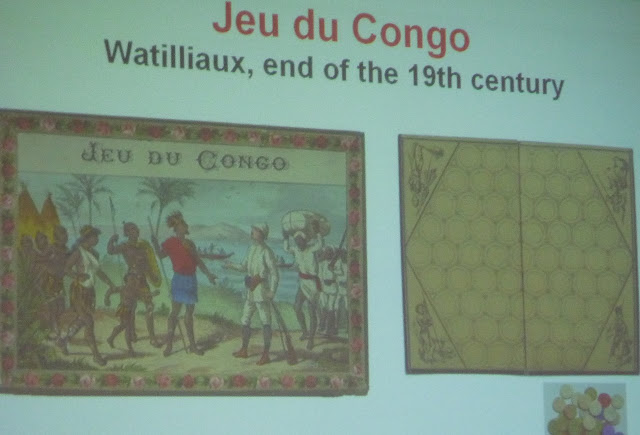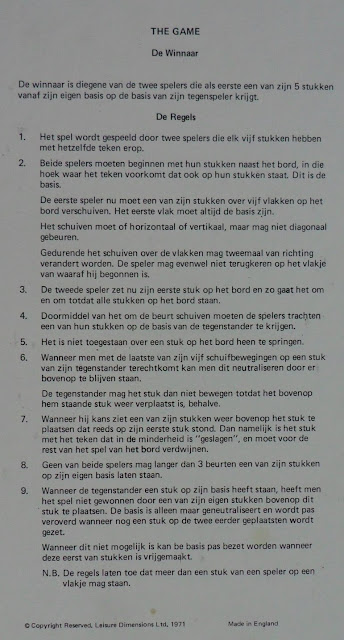OCTATOL
Move sequence 36* with group restriction
(i.e., no two stones dropped in the same group/turn)
TO WIN: join 2 opposite groups, OR make a Y that prevents this.
Initial setup:
| abcdefghijklmnopqrstuvwxyzABC
| X X X O O O
| O . . . . . . . X 1
| O . . . . . . . . X 2
| O . . . . . . . . . X 3
| X . . . . . . . . . O 4
| X . . . . . . . . . . . O 5
| X . . . . . . . . . . . . O 6
| . . . . . . . . . . . . . . . 7
| O . . . . . . . . . . . . . . X 8
| O . . . . . . . . . . . . . . X 9
| O . . . . . . . . . . . . . . X 10
| . . . . . . . . . . . . . . . 11
| X . . . . . . . . . . . . . . O 12
| X . . . . . . . . . . . . . . . O 13
| X . . . . . . . . . . . . . . O 14
| . . . . . . . . . . . . . . . 15
| O . . . . . . . . . . . . X 16
| O . . . . . . . . . . . X 17
| O . . . . . . . . . . X 18
| X . . . . . . . . . O 19
| X . . . . . . . . O 20
| X . . . . . . . O 21
| O O O X X X
| abcdefghijklmnopqrstuvwxyzABC
Game sample:
| abcdefghijklmnopqrstuvwxyzABC OO starts
| X X X O O O ~~~~~~~~~~~~~~~~~~~~~~~~~~~~~
| O x . . . o . . X 1. .. .. .. o9 l12 r12
| O . . . . . . . . X 2. j10 t10 m11 q11 o13 o15
| O . x . . . o . . . X 3. o7 p10 s11 r14 n12 i13
| X . . . . . o . . . O 4. u9 j12 p12 s13 j14 n16
| X . x . . . o . . . . . O 5. o5 r10 k13 n14 f12 f14
| X . . . o . . . . . . . . O 6. f8 n8 o11 l14 q15 t16
| . x . . . . o o . . . . . . . 7. j8 g9 p8 g13 p14 u15
| O . x x x o . x o . . . . . . X 8. h8 f10 c11 i11 q13 s15
| O . o x o o . o o . . x . . . X 9. j6 i9 g11 l10 l16 t14
| O . x x o x o . o o x . . . . X 10. d10 k11 d14 g15 m15 w17
| x x . o x x x x x o . . . . . 11. m7 h10 w13 f16 i15 i17
| X . x o . x o o x o . . . . . O 12. d8 a11 e15 g17 m17 l20
| X . o o o o o o x x x . o . . . O 13. q3 m9 h14 i19 i21 k17
| X x x o o x x o o o o . . . . O 14. k15 h16 j18 x18 m19 h20
| . o x x o x x x x x o . . . . 15. m13 f18 j20 l18 u17 u19
| O . o x x o x . . x o . . X 16. c7 d12 j16 q17 t18 q19
| O . x o o x . x * o x . X 17. c9 c13 c15 n18 r18 v16
| O o o x o o x o x x x X 18. e9 p18 v18 k19 v20 s21
| X . o x x . x o o x O 19. q1 p4 h18 p20 s19 u21
| X x o x . o x * x O 20. i1 i3 g5 c14 w19 r20
| X o . . . . x o O 21. OO resigns (x forces at one of the *s)
| O O O X X X
| abcdefghijklmnopqrstuvwxyzABC
This game is based on Atoll, a game from Mark Steere






























